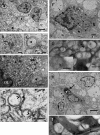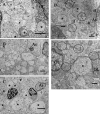Cellular compensatory mechanisms in the CNS of dysmyelinated rats
- PMID: 20579436
- PMCID: PMC2890396
Cellular compensatory mechanisms in the CNS of dysmyelinated rats
Abstract
Loss or absolute lack of myelin in the CNS results in remarkable compensation at the cellular level. In this study on the natural progression of neuropathology in the CNS in 2 related but distinct long-lived dysmyelinated rats, total lack of myelin was associated with remarkable glial cell proliferation and ineffective myelinating activity throughout life in Long Evans Bouncer (LE-bo) rats; conversely, in Long Evans Shaker (LES) rats, futile myelinating activity ceased when rats were advanced in age. Progressively severe astrogliosis separates individual axons from each other and coincides with widespread, abundant axonal sprouting throughout the life in both rat strains. Severely dysmyelinated Long Evans rats can serve as excellent models to elucidate the cellular and molecular mechanisms of neuroglial compensation to lack or loss of myelin in vivo and to study axonal plasticity in the adult demyelinated CNS.
Figures







References
-
- Allen IV, Kirk J. 1992. Demyelinating diseases, p 447–520 In: Adams JH, Duchen LW, Greenfield's neuropathology. New York (NY): Oxford University Press
-
- Baracskay KL, Duchala CS, Miller RH, Macklin WB, Trapp BD. 2002. Oligodedrogenesis is defferentially regulated in gray and white matter of jimpy mice. J Neurosci Res 70:645–654 - PubMed
-
- Baumann N, Pham-Dinh D. 2001. Biology of oligodendrocyte and myelin in the mammalian central nervous system. Physiol Rev 81:871–927 - PubMed
Publication types
MeSH terms
LinkOut - more resources
Full Text Sources
